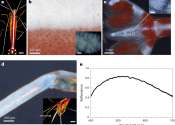Researchers observe extremely squeezed directional THz waves in thin semiconductor crystals
An international team of scientists has imaged and analyzed THz waves that propagate in the form of plasmon polaritons along thin anisotropic semiconductor platelets with wavelengths reduced by up to 65 times compared to ...









